Page 2280 of 2305
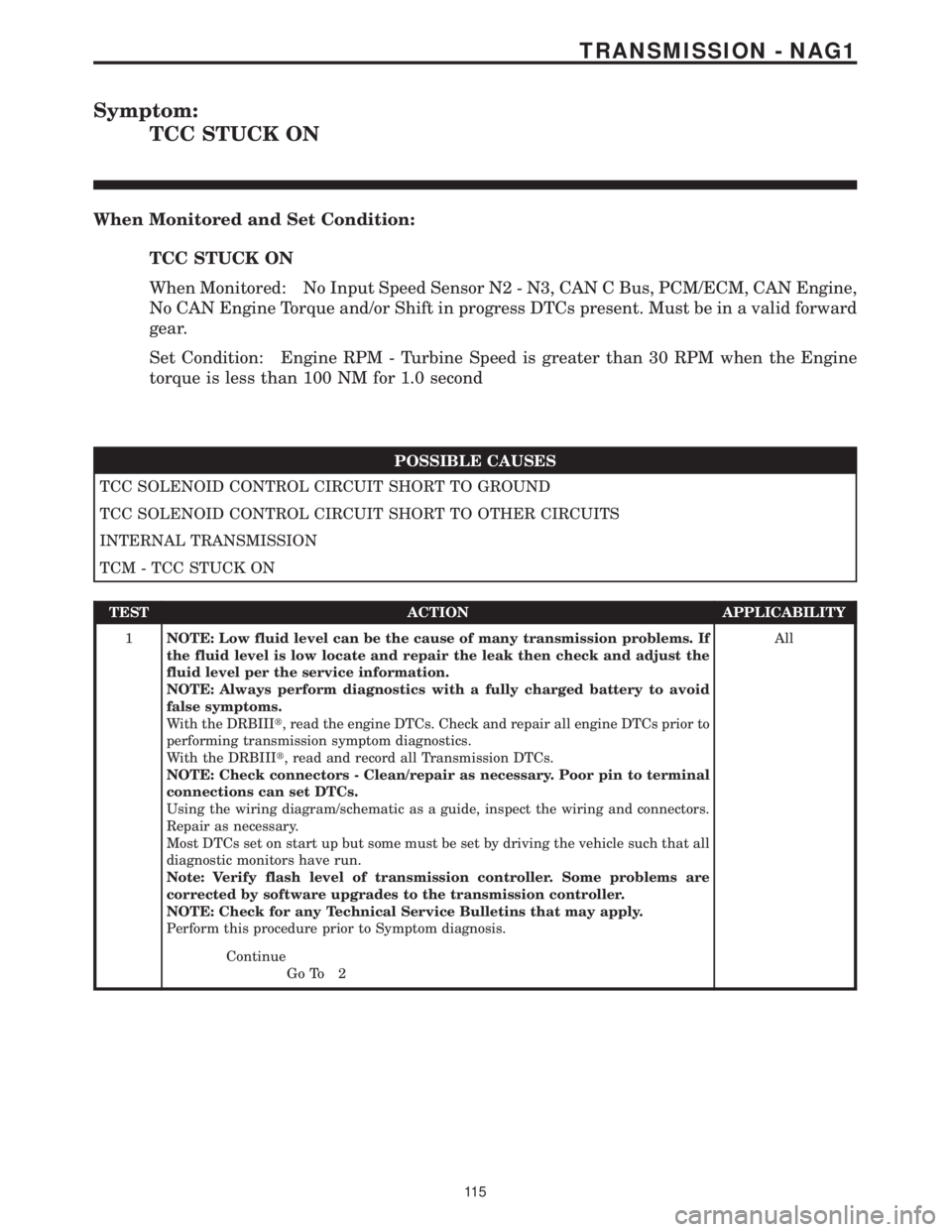
Symptom:
TCC STUCK ON
When Monitored and Set Condition:
TCC STUCK ON
When Monitored: No Input Speed Sensor N2 - N3, CAN C Bus, PCM/ECM, CAN Engine,
No CAN Engine Torque and/or Shift in progress DTCs present. Must be in a valid forward
gear.
Set Condition: Engine RPM - Turbine Speed is greater than 30 RPM when the Engine
torque is less than 100 NM for 1.0 second
POSSIBLE CAUSES
TCC SOLENOID CONTROL CIRCUIT SHORT TO GROUND
TCC SOLENOID CONTROL CIRCUIT SHORT TO OTHER CIRCUITS
INTERNAL TRANSMISSION
TCM - TCC STUCK ON
TEST ACTION APPLICABILITY
1NOTE: Low fluid level can be the cause of many transmission problems. If
the fluid level is low locate and repair the leak then check and adjust the
fluid level per the service information.
NOTE: Always perform diagnostics with a fully charged battery to avoid
false symptoms.
With the DRBIIIt, read the engine DTCs. Check and repair all engine DTCs prior to
performing transmission symptom diagnostics.
With the DRBIIIt, read and record all Transmission DTCs.
NOTE: Check connectors - Clean/repair as necessary. Poor pin to terminal
connections can set DTCs.
Using the wiring diagram/schematic as a guide, inspect the wiring and connectors.
Repair as necessary.
Most DTCs set on start up but some must be set by driving the vehicle such that all
diagnostic monitors have run.
Note: Verify flash level of transmission controller. Some problems are
corrected by software upgrades to the transmission controller.
NOTE: Check for any Technical Service Bulletins that may apply.
Perform this procedure prior to Symptom diagnosis.All
Continue
Go To 2
11 5
TRANSMISSION - NAG1
Page 2282 of 2305
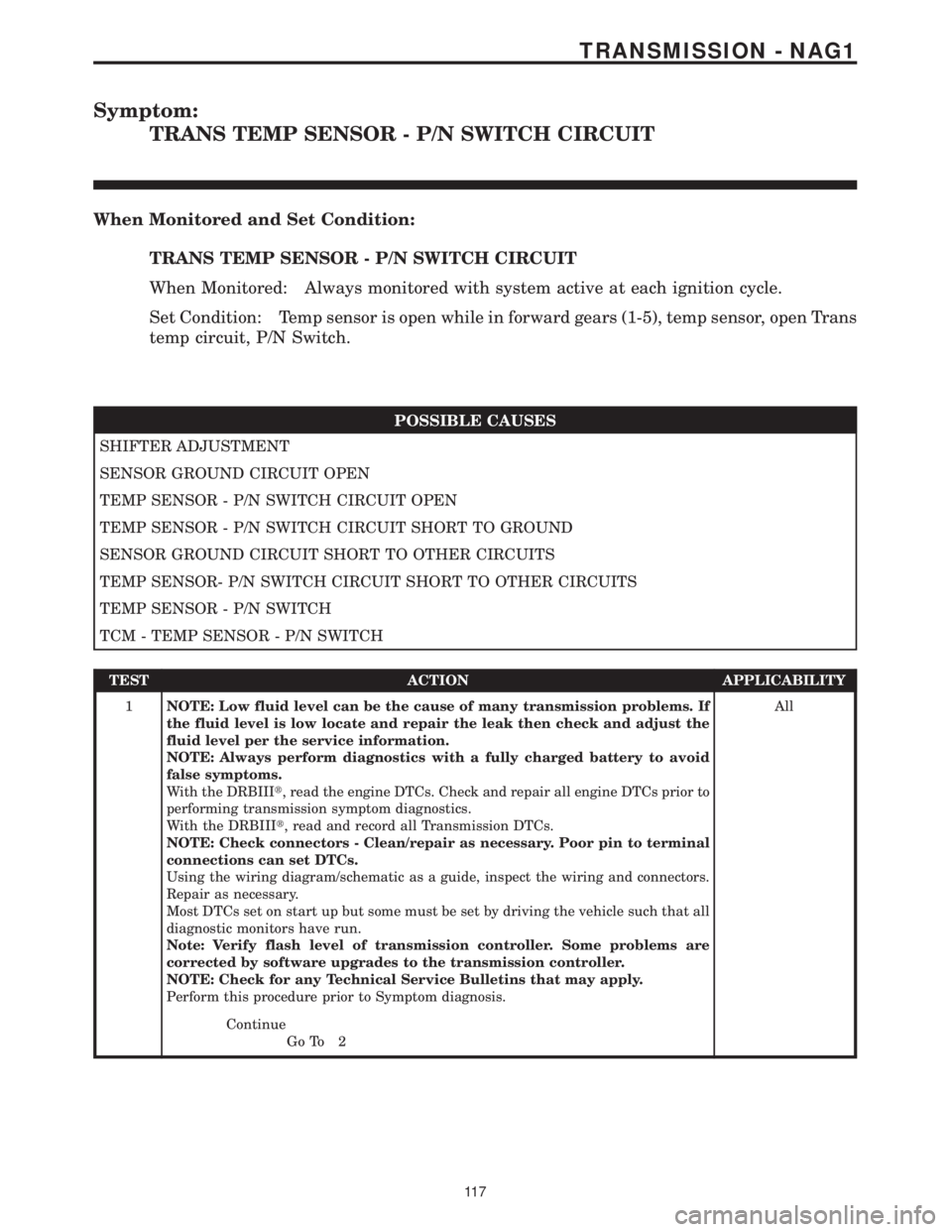
Symptom:
TRANS TEMP SENSOR - P/N SWITCH CIRCUIT
When Monitored and Set Condition:
TRANS TEMP SENSOR - P/N SWITCH CIRCUIT
When Monitored: Always monitored with system active at each ignition cycle.
Set Condition: Temp sensor is open while in forward gears (1-5), temp sensor, open Trans
temp circuit, P/N Switch.
POSSIBLE CAUSES
SHIFTER ADJUSTMENT
SENSOR GROUND CIRCUIT OPEN
TEMP SENSOR - P/N SWITCH CIRCUIT OPEN
TEMP SENSOR - P/N SWITCH CIRCUIT SHORT TO GROUND
SENSOR GROUND CIRCUIT SHORT TO OTHER CIRCUITS
TEMP SENSOR- P/N SWITCH CIRCUIT SHORT TO OTHER CIRCUITS
TEMP SENSOR - P/N SWITCH
TCM - TEMP SENSOR - P/N SWITCH
TEST ACTION APPLICABILITY
1NOTE: Low fluid level can be the cause of many transmission problems. If
the fluid level is low locate and repair the leak then check and adjust the
fluid level per the service information.
NOTE: Always perform diagnostics with a fully charged battery to avoid
false symptoms.
With the DRBIIIt, read the engine DTCs. Check and repair all engine DTCs prior to
performing transmission symptom diagnostics.
With the DRBIIIt, read and record all Transmission DTCs.
NOTE: Check connectors - Clean/repair as necessary. Poor pin to terminal
connections can set DTCs.
Using the wiring diagram/schematic as a guide, inspect the wiring and connectors.
Repair as necessary.
Most DTCs set on start up but some must be set by driving the vehicle such that all
diagnostic monitors have run.
Note: Verify flash level of transmission controller. Some problems are
corrected by software upgrades to the transmission controller.
NOTE: Check for any Technical Service Bulletins that may apply.
Perform this procedure prior to Symptom diagnosis.All
Continue
Go To 2
11 7
TRANSMISSION - NAG1
Page 2285 of 2305
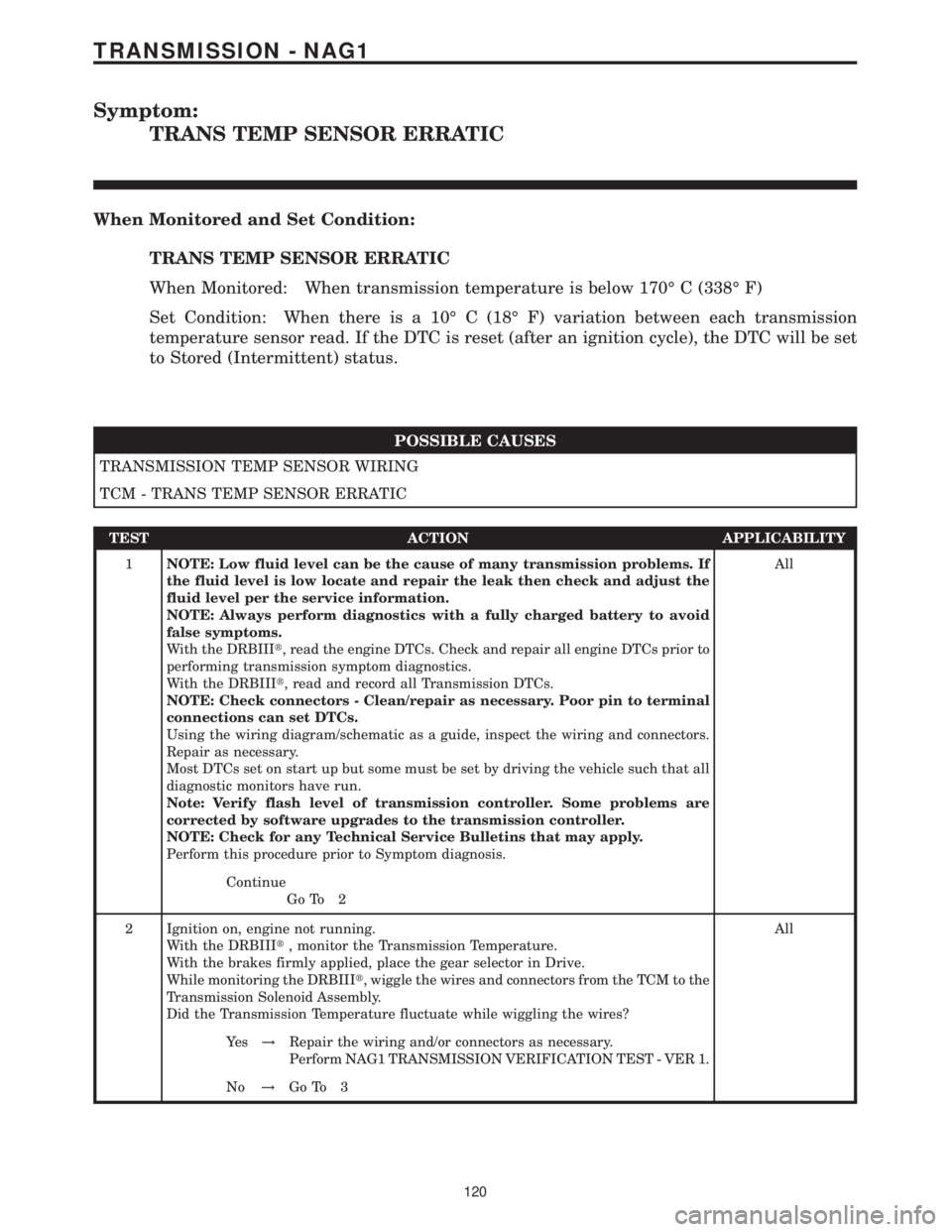
Symptom:
TRANS TEMP SENSOR ERRATIC
When Monitored and Set Condition:
TRANS TEMP SENSOR ERRATIC
When Monitored: When transmission temperature is below 170É C (338É F)
Set Condition: When there is a 10É C (18É F) variation between each transmission
temperature sensor read. If the DTC is reset (after an ignition cycle), the DTC will be set
to Stored (Intermittent) status.
POSSIBLE CAUSES
TRANSMISSION TEMP SENSOR WIRING
TCM - TRANS TEMP SENSOR ERRATIC
TEST ACTION APPLICABILITY
1NOTE: Low fluid level can be the cause of many transmission problems. If
the fluid level is low locate and repair the leak then check and adjust the
fluid level per the service information.
NOTE: Always perform diagnostics with a fully charged battery to avoid
false symptoms.
With the DRBIIIt, read the engine DTCs. Check and repair all engine DTCs prior to
performing transmission symptom diagnostics.
With the DRBIIIt, read and record all Transmission DTCs.
NOTE: Check connectors - Clean/repair as necessary. Poor pin to terminal
connections can set DTCs.
Using the wiring diagram/schematic as a guide, inspect the wiring and connectors.
Repair as necessary.
Most DTCs set on start up but some must be set by driving the vehicle such that all
diagnostic monitors have run.
Note: Verify flash level of transmission controller. Some problems are
corrected by software upgrades to the transmission controller.
NOTE: Check for any Technical Service Bulletins that may apply.
Perform this procedure prior to Symptom diagnosis.All
Continue
Go To 2
2 Ignition on, engine not running.
With the DRBIIIt, monitor the Transmission Temperature.
With the brakes firmly applied, place the gear selector in Drive.
While monitoring the DRBIIIt, wiggle the wires and connectors from the TCM to the
Transmission Solenoid Assembly.
Did the Transmission Temperature fluctuate while wiggling the wires?All
Ye s!Repair the wiring and/or connectors as necessary.
Perform NAG1 TRANSMISSION VERIFICATION TEST - VER 1.
No!Go To 3
120
TRANSMISSION - NAG1
Page 2287 of 2305
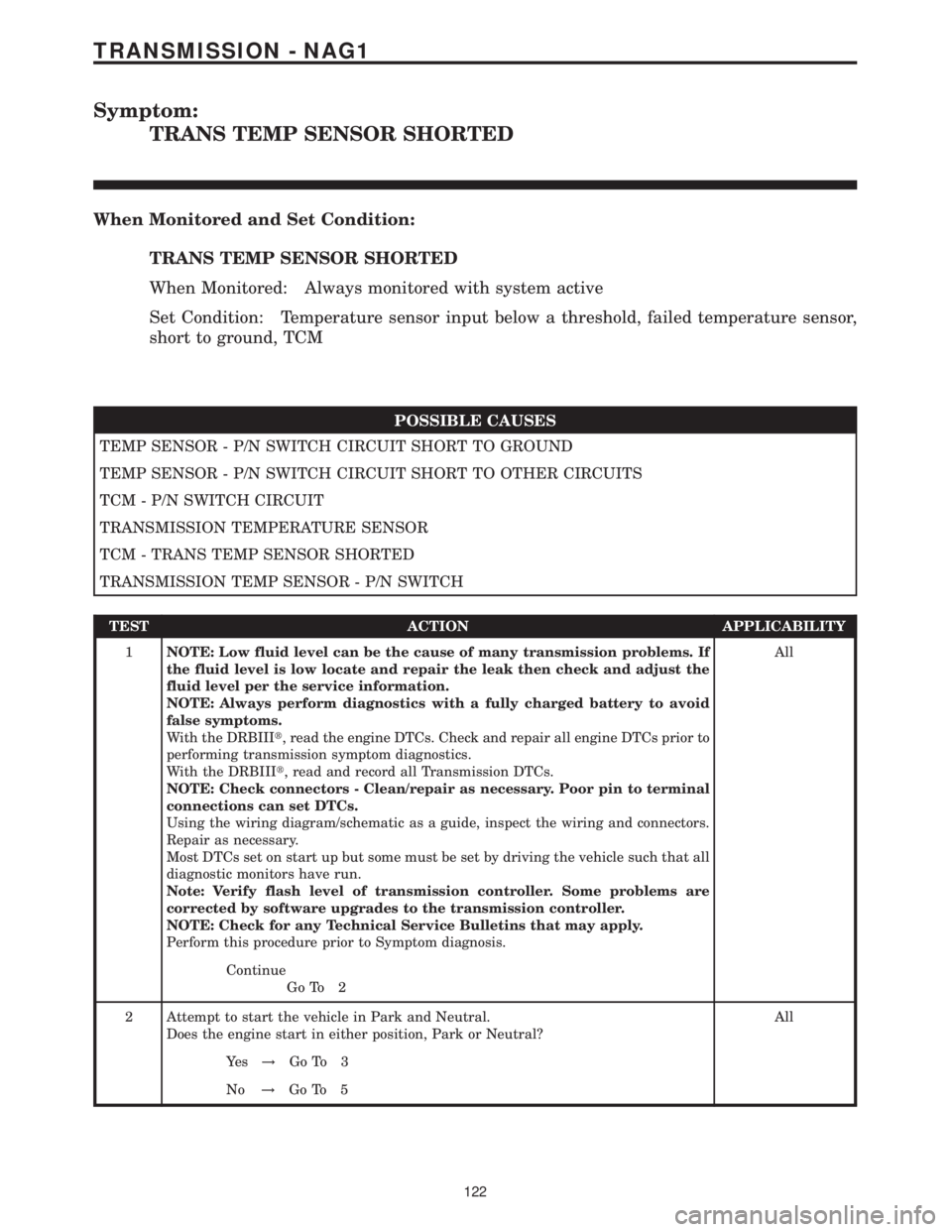
Symptom:
TRANS TEMP SENSOR SHORTED
When Monitored and Set Condition:
TRANS TEMP SENSOR SHORTED
When Monitored: Always monitored with system active
Set Condition: Temperature sensor input below a threshold, failed temperature sensor,
short to ground, TCM
POSSIBLE CAUSES
TEMP SENSOR - P/N SWITCH CIRCUIT SHORT TO GROUND
TEMP SENSOR - P/N SWITCH CIRCUIT SHORT TO OTHER CIRCUITS
TCM - P/N SWITCH CIRCUIT
TRANSMISSION TEMPERATURE SENSOR
TCM - TRANS TEMP SENSOR SHORTED
TRANSMISSION TEMP SENSOR - P/N SWITCH
TEST ACTION APPLICABILITY
1NOTE: Low fluid level can be the cause of many transmission problems. If
the fluid level is low locate and repair the leak then check and adjust the
fluid level per the service information.
NOTE: Always perform diagnostics with a fully charged battery to avoid
false symptoms.
With the DRBIIIt, read the engine DTCs. Check and repair all engine DTCs prior to
performing transmission symptom diagnostics.
With the DRBIIIt, read and record all Transmission DTCs.
NOTE: Check connectors - Clean/repair as necessary. Poor pin to terminal
connections can set DTCs.
Using the wiring diagram/schematic as a guide, inspect the wiring and connectors.
Repair as necessary.
Most DTCs set on start up but some must be set by driving the vehicle such that all
diagnostic monitors have run.
Note: Verify flash level of transmission controller. Some problems are
corrected by software upgrades to the transmission controller.
NOTE: Check for any Technical Service Bulletins that may apply.
Perform this procedure prior to Symptom diagnosis.All
Continue
Go To 2
2 Attempt to start the vehicle in Park and Neutral.
Does the engine start in either position, Park or Neutral?All
Ye s!Go To 3
No!Go To 5
122
TRANSMISSION - NAG1
Page 2290 of 2305
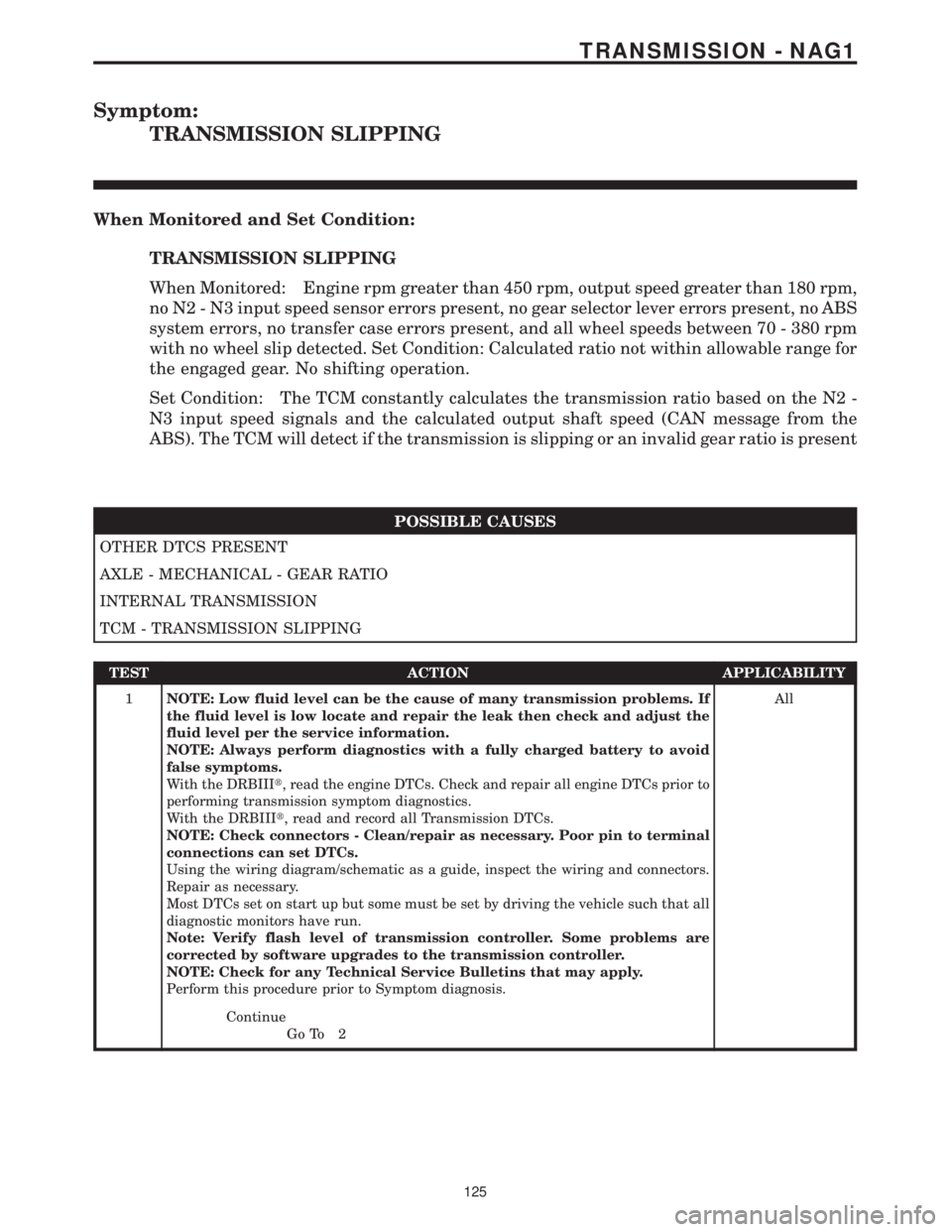
Symptom:
TRANSMISSION SLIPPING
When Monitored and Set Condition:
TRANSMISSION SLIPPING
When Monitored: Engine rpm greater than 450 rpm, output speed greater than 180 rpm,
no N2 - N3 input speed sensor errors present, no gear selector lever errors present, no ABS
system errors, no transfer case errors present, and all wheel speeds between 70 - 380 rpm
with no wheel slip detected. Set Condition: Calculated ratio not within allowable range for
the engaged gear. No shifting operation.
Set Condition: The TCM constantly calculates the transmission ratio based on the N2 -
N3 input speed signals and the calculated output shaft speed (CAN message from the
ABS). The TCM will detect if the transmission is slipping or an invalid gear ratio is present
POSSIBLE CAUSES
OTHER DTCS PRESENT
AXLE - MECHANICAL - GEAR RATIO
INTERNAL TRANSMISSION
TCM - TRANSMISSION SLIPPING
TEST ACTION APPLICABILITY
1NOTE: Low fluid level can be the cause of many transmission problems. If
the fluid level is low locate and repair the leak then check and adjust the
fluid level per the service information.
NOTE: Always perform diagnostics with a fully charged battery to avoid
false symptoms.
With the DRBIIIt, read the engine DTCs. Check and repair all engine DTCs prior to
performing transmission symptom diagnostics.
With the DRBIIIt, read and record all Transmission DTCs.
NOTE: Check connectors - Clean/repair as necessary. Poor pin to terminal
connections can set DTCs.
Using the wiring diagram/schematic as a guide, inspect the wiring and connectors.
Repair as necessary.
Most DTCs set on start up but some must be set by driving the vehicle such that all
diagnostic monitors have run.
Note: Verify flash level of transmission controller. Some problems are
corrected by software upgrades to the transmission controller.
NOTE: Check for any Technical Service Bulletins that may apply.
Perform this procedure prior to Symptom diagnosis.All
Continue
Go To 2
125
TRANSMISSION - NAG1
Page 2300 of 2305
10.0 SCHEMATIC DIAGRAMS
S
C
H
E
M
A
T
I
C
D
I
A
G
R
A
M
S
135
SCHEMATIC DIAGRAMS